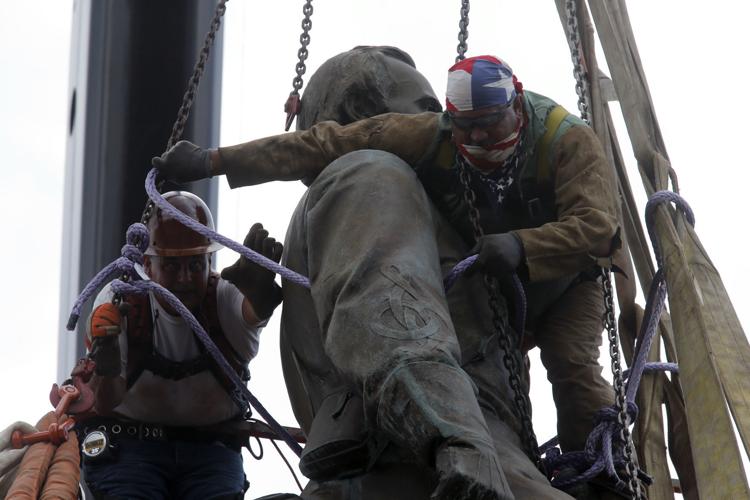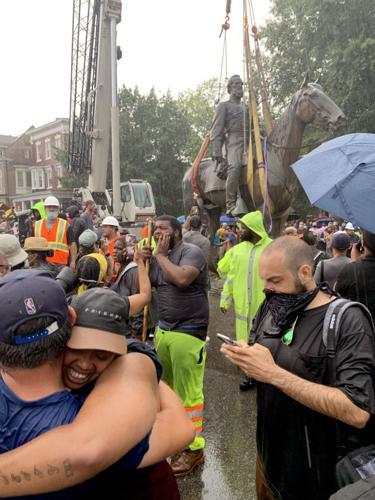Viewers celebrate as Stonewall Jackson statue is hauled away
For more than a century, the larger-than-life bronze of Stonewall Jackson towered above one of our most prominent intersections, a symbol of Richmond’s immutability.
“We place today on a high pedestal Virginia’s flawless knight,” Col. Robert E. Lee, grandson of the general, said at the Oct. 11, 1919, unveiling of the monument.
But recently, seemingly all at once for a critical mass of folks, the flaws in this narrative became too hideous to ignore as Richmond reached a saturation point for Lost Cause propaganda. Jackson’s street address was changed to Arthur Ashe Boulevard in honor of the Richmond native, tennis champion and human rights activist whose aspirations were stymied in his hometown by the white supremacy Jackson fought to uphold.
We are now a city in search of heroes and causes we can all rally around. Jackson never qualified. Wednesday, under a gray sky, his likeness was lifted from a perch it never should have occupied in a just and evolved society.
Amid a national reckoning on race after the torture of George Floyd at the hands of police, Richmond could no longer reconcile its racist iconography.
Black Lives Matter demonstrators have attempted to topple Confederate monuments, with varying degrees of success. Finally, on the first day Richmond could take down Confederate statues under a new state law, Mayor Levar Stoney ordered Jackson’s removed as a public safety hazard.
When a crane raised the 17½-foot bronze statue off the granite pedestal, the weight of Richmond history became more bearable. But there’s much heavier lifting to be done.
I’m not just talking about Jackson’s Confederate cohorts. Even before all the symbols of white supremacy are removed, we need to take a wrecking ball to the institutions that help sustain the real thing.
Wednesday at Monument Avenue and Ashe Boulevard was an afternoon of false starts, with enthusiasm uncorked and bubbling to the top before being stuffed back into the bottle. The atmosphere was like that before the lights dim at a rock concert, with the throngs surrounding the Jackson statue applauding at the slightest sign that the show was about to begin.
They chanted: “Whose streets? Our streets!” and “Black Lives Matter!” and sang the refrain from the old Steam classic, “Na na na na, na na na na, hey, hey, good bye.”
April Gage, a native Canadian, stood on the median holding her 8-month-old daughter. “Just coming here and watching is good for keeping all your thoughts flowing through this time,” she said. “This is the moment we’re in.”
Bryan Bailey observed the scene from a distance. “It’s about time,” was his assessment.
The beeping crane maneuvered and power tools whirred. But as the minutes turned to hours, there stood Jackson, like a stone wall. The moment began to echo December’s “Rumors of War” unveiling at the Virginia Museum of Fine Arts, with our transition from old to new Richmond delayed by a tarp unwilling to let go. Jackson was harnessed but seemingly refused to surrender. Then again, we’re talking about extracting bronze from a granite base, not pulling apart Legos.
Finally, the statue lifted off its pedestal to cheers before hanging suspended for a moment. By now, it was pouring, and a bell tolled in the background.
Someday, it will be universally acknowledged that July 1, 2020, was a great day in the city of Richmond — the moment this city finally began divorcing itself from the Confederacy. The fall of Stonewall is just a start. We need to begin earnest work building a Richmond we can be proud of.
“A city cannot consistently transform itself at the expense of its most marginalized citizens and not expect those citizens to have a vast imagination about what a further transformation — whether of statues, a name or leadership — could be,” wrote Hanif Abdurraqib in The New Yorker.
Abdurraqib, a Columbus, Ohio, native, was speaking of his city and the troubling legacy surrounding its namesake. But the same could be written of Richmond, a city whose sense of possibility calcified when it chose to attach its identity to an irredeemable cause.
Richmond, and the nation, are in a long-overdue moment of self-assessment, and no less than our future depends on it. No good can come out of defining ourselves by four of the bloodiest years in the nation’s history and honoring, in our most prominent spaces, agents of treason and enslavement.
Removal of this monument and others will mean nothing if we don’t expand our imagination about what we can and should be.







